R&D Alliance Program (Click For Details) – The Fanger
I have been working on this left of centre design over the past 5 years and have made numerous versions. It was a struggle to design because of the slice variation at either end and I have had to go a little more subtle in order to smooth the bumps from the rail shoulder line. The concept is to have a really thick tail that bights. The benefit of this is that you can keep running regardless of how deep you bury the tail. Tails that are too thin are easy to bury and pivot but they stay buried for too long and simply do not run. A tail which is too thick on the stringer more often than not will be too thick on the rail and be difficult to bight and hold. So the objective for this design was to have thickness in the tail on the stringer but not on the rail.
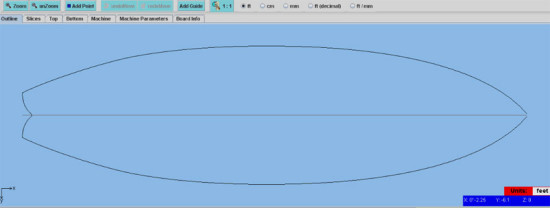
The way this has been done is to design a heavy vee into the bottom in the tail area as well as a heavy rolled vee on the deck in the same area. Both these vees squeeze the thickness out of the rail and make it easy to engage and bury. Having too thin a rail all the way through to the nose would make the rail bury too easy and make the board to sensitive so I have done the opposite to the rail slice up front. That is- made both the deck and the bottom heavily concaved on the nose slice, which squeezes all the thickness out to the rails in that area.
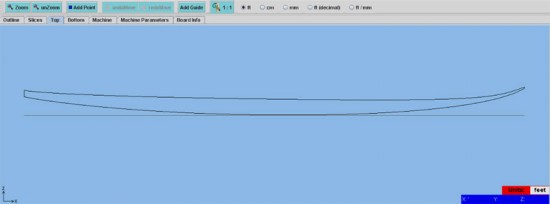
This radical slice would make the rails way too thick up front if I was to keep the stringer profile the same thickness as normal boards on the nose, so the nose profile has to be reduced right down in thickness to keep the rail thickness in check. Effectively this keeps the front half from feeling too front heavy, although it may seem it is if you were to judge by the rail thickness forward of centre.
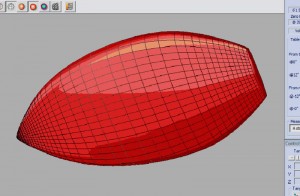 This board looks and feels front heavy, but volume wise it is not. Having a very buriable back half is countered by having a resisting thicker rail forward of centre which in essence allows one to sink the tail rail and drive off the thicker rail forward not to mention the forgiveness that extra foam forward gives to a surfer that pins his heart on his front foot. And all the time the board just keeps on running regardless because of all that rear thickness just lifts up and pushes forward.
This board looks and feels front heavy, but volume wise it is not. Having a very buriable back half is countered by having a resisting thicker rail forward of centre which in essence allows one to sink the tail rail and drive off the thicker rail forward not to mention the forgiveness that extra foam forward gives to a surfer that pins his heart on his front foot. And all the time the board just keeps on running regardless because of all that rear thickness just lifts up and pushes forward.
Firstly I designed this as primarily a quad but by pulling the tail in a little more I have made it perform pretty good as a thruster also. Remembering that with this radical new design the tail rail is so thin that it automatically relieves pressure off the rear centre fin.
The thruster rear fin’s job it is to secure the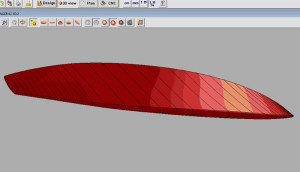 tail rail to the face so as not to slide out when pressured through turns and when the rail buries easily the less loading there is on that fin. This is why even though the tail is widish for a thruster it is flying and holding to the face in waves bigger that it is meant to. I have print screened a few 3D shots of the design, only it will not allow me to put in the swallow, as shaping machines eat themselves up if they try to cut in a swallow tail- so we do that ourselves. Also supplied are a few PDF’s showing the different slices at both ends as well as a profile showing how thin the board is on the stringer up front, as well as the thickness in the tail. Lastly a good depiction of the planshape showing the hip in the tail.
tail rail to the face so as not to slide out when pressured through turns and when the rail buries easily the less loading there is on that fin. This is why even though the tail is widish for a thruster it is flying and holding to the face in waves bigger that it is meant to. I have print screened a few 3D shots of the design, only it will not allow me to put in the swallow, as shaping machines eat themselves up if they try to cut in a swallow tail- so we do that ourselves. Also supplied are a few PDF’s showing the different slices at both ends as well as a profile showing how thin the board is on the stringer up front, as well as the thickness in the tail. Lastly a good depiction of the planshape showing the hip in the tail.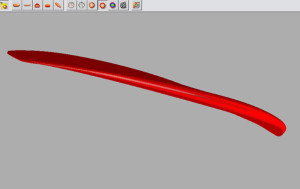
As I have said, I have made quite a few of these experimental boards and the feedback has been really good (some testimonials attached). Because the board looks a little weird it may take a wave of testimonials to have people believe that this rail warped concoction has merit. One of its believers demanded the right to name it, and he has come up with “The Fanger” ….so be it!
The Fanger Test Pilot Position Has Been Filled & the board is being created. Keep your eyes out for the Next Prototype

